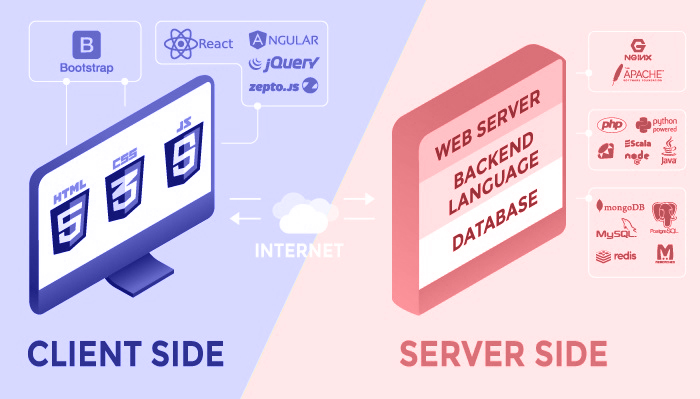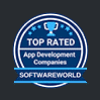What’s the most important thing to grant when you’re developing a top-notch web application? No doubt it’s the technology stack your app will be relied upon. Are you a founder, CEO, CTO, consultant or other stakeholders who require to decide how to build a software product? Having trouble choosing on the tech stack for your web application? It may be the Python or Java you use as a language? Is it the right choice – node.js or Flask/ Django for the web framework? What is the best front-end option – Angular, React or Vue.JS? What about database – MySQL, or MongoDB? Should you self-host with Apache or just go with Amazon AWS? All this make you a lot of confusing!
The choice of a suitable tech stack is particularly challenging for small businesses and startups. Since they usually have limited budgets and thus need a technology stack that provides the most thrill for the buck to get their projects off the ground.
Even from the client side, the main thing is that the application performs correctly and the choice of technology is the developers’ business. That ‘s absolutely true, but the technology directly affects the application performance. The contrary is also true – the type of application influences the technology selection.
This is the reason we shared our views on choosing the technology stack for web application development and the criteria we use in the process. Moreover, web app development does not stop with the primary release – any working app requires continuous support and maintenance. By knowing the technology stack used during development will make further updates easier, even if you decide to change the development service provider.
What is a Technology Stack?
The technology stack is a kit of tools and frameworks that are used in the development of a software product. In other words, it is the combination of programming languages, frameworks and tools that are used by the developers for the development of web and mobile applications.
- Client-side
- Server-side
This can also be known as Front-end and Back-end. These are the main pillars of the application software.
Client-side Programming
From client-side(Front-end) web application development involves everything users see on their screens. Here are the major frontend technology stack components:
- HTML(Hyper Text Markup Language) defines the structure of the information presented in the browser.
- CSS(Cascading Style Sheets) determines the style of the application content such as colour, fonts, and layouts.
- JavaScript enables the interactivity of the web page in which the app is running.
Most of the web applications are built with Bootstrap as the framework for HTML and CSS. It is considered the most expansive library with a great user base and thousands of stars on GitHub. While Bootstrap is the most popular framework it is not the only on the market. The second most used after Bootstrap is Foundation which shows good performance.
When it comes to JavaScript components are a field of fierce competition of front-end frameworks, the most used are Angular and React. Both are well-known for their high performance and flexibility, and both have huge armies of supporters and contributors. Moreover, both of them work equally well regardless of the tools used on the back end.
Server-side or Back-end
The server-side components aren’t visible to the users, but it powers the client-side, just as a power station generates electricity for your home. The most challenges lie majorly in the choice of the server-side technology for developing your web application. As server-side programming languages, they are used to create the logic of websites and applications. Frameworks for programming languages offer lots of tools for milder and faster coding. All back-end tech stacks hold the following main parts:
- An operating system where the development part takes place
- Web server request processing from the browser and returning the corresponding content.
- A database that stores the app data
- A programming language which utilizes to create the app code
- Web development framework used for faster and easier development. The web framework directly depends on the selection of the programming language.
As you all know the web application requires a place to store the data and that’s what is known as a database. In general, there are two types of databases:
- Relational
- Non-relational
Here are the most typical databases for web development:
- MySQL (relational)
- PostgreSQL (relational)
- MongoDB (non-relational, document)
A web application requires a caching system to reduce the load on the database and to handle large amounts of traffic. Memcached and Redis are the most popular caching systems. Finally, a web application requires a server to handle requests from the client’s computers. There are two major players in this domain:
- Apache
- Nginx
How to pick the right Technology stack for development of Web Applications
With this wide variety of web development tools, platforms and stacks, choosing the one that will work best for your project development may seem like a difficult task. That’s absolutely the true fact, choosing the technology is a project within a project and needs certain effort, but this choice determines how your application is going to create a run and maintained.
The tech stack parts interaction
Project Size and Type
The first and foremost thing to decide upon is the type of web application you’re developing. A tech stack is a toolset for developing a web application, so you need to fully realize what you’re planning to build in order to pick the appropriate tools. You should determine a toolset that provides unique advantages for your web application. The volume and complexity of your project may be a factor determining the stack that you choose to develop it.
Software projects can be classified into 3 types based on the complexity:
- Low complexity projects involve out-of-the-box-solutions, CMS, web templates appliance to build landing pages, plain e-shops, and applications; minimum staffing is involved when developing.
- Medium complexity projects such as online stores, marketplaces, enterprise solutions are usually created based on frameworks; involve staff from more than one department.
- High complexity projects imply eCommerce solutions, large portals, data-based applications development with a combination of frameworks, software languages, tools, accelerators; extensive cross-departmental interaction.
Once you are done with the type of web application to develop that is not just enough; you should take its business goals into account as well. This is a very primary thing to do because your goals impact the choice of technologies for development. Your web app can be tailored for:
- Heavy Load Processing –If your web project relies on load processing, you should opt for programming languages and frameworks that can provide this. Examples of such outlines are video/audio streaming apps and file sharing services.
- Low Latency – A different tech stack is required to make your web application highly responsible and to reduce latency. Social networks are apparently the best example of websites that require low latency.
Time to market:
Time to market is extremely important when choosing a tech stack for small businesses. The faster you develop and release your application, the more ahead of opponents you’ll be. Moreover, the less time development needs the cheaper the development cost.
Time to Market depends on the technology stack you select for your web application and here’s a list of the issue you consider when choosing a proper stack:
- Out of the box solutions – It is also known as Off-the-Shelfreferser to software that can be installed ready-made for the general public. One of the positives of the mentioned software is ready to be installed.
- Third Party Integration – Ensure the tech stack you selected enables a great number of third-party integration as it helps you to add the functions that you need in your web application without reinventing the wheel.
- Availability of developers – In order to turn your idea into a great and outstanding web application solution then you need to find a skilful and experienced team who can apply the chosen tools. But it just not ended here at all the support should be proceeded even after the web application launched.
- Documentation and developer community – While coding any developers team will encounter the tricky issues and solving the problem can be time-consuming. Big developer communities rich documents and specifications can help to handle issues in order not to miss the web application project deadlines.
- Easy testing – Every digital product contains coding lines that will certainly have bugs to be fixed. It is a must thing to remove all the failures that bottleneck the development process. Testing solutions that help to avoid this problem as some of them include test-driven approach by default to warrant the quality.
Development Cost:
It’s not that much necessary to say turning your idea into a real-life web application is not for free of charge and requires investment. The charges will depend on applying software tools when developing a web product. Consider the positive correlation between selected software stack and cost when the tech stack is more advanced the that imply the high development cost. There are two main problems you need to consider:
- Developer Salaries – Web developers are highly professionals who are rather well-paid. However, their salaries depend on the technologies they work with. Simultaneously, your expenses will be different depending on the tech stack. You should remember that more advanced the technology is the higher the developer salary will be.
- App Maintenance cost – Developing the web application is just like one side of the coin; maintaining it is the other. To diminish maintenance costs, you should opt for free open-source technologies.
Scalability:
Growing products require a well-defined scalability matrix that should have scenarios for both scale up(Vertical) and scale out(Horizontal).
- Scale up or vertically – enabling you to add other software for new tasks
- Scale out or horizontally – allowing it to handle increased volumes of a request
Security:
Always ensure the web application is developed on the safety principles in order to avoid threats, minimize critical areas. It is needed to select software technologies that have safety and security instructions in order to create a highly secure, protected web product.
Technology Stacks Behind Successful Web Projects
- Airbnb, the world’s most well-known hospitality service that helps millions of people find rental apartments and short-term lodging.
- Instagram, a mainstream social networking application, is built with Python.
- Facebook is the world’s biggest social network with almost 2 billion active monthly users.
- Shopify helps entrepreneurs power their online stores
Pick a Technology Stack According to Your Project
As you can see, selecting the proper tech stack is a real challenge, but the core idea that should guide you is as follows: Choose the technologies according to your project. Never rely on time-proven technologies only, even if they have been used by some large and successful companies or prominent projects have been accomplished with their help.
Always be genuine and take all the pros and cons into account. The wrong selection of a technology stack may end in financial losses, so if you aren’t experienced in web development, leave the choice to professionals. A team of professional web developers will be able to choose the right tools for delivering a top-notch web application with all the functionality you require.
Bottom Line
Determining the software technologies based on the requirements of the future products is the underlying concept. It is not a good idea to defer to time-tested tools, even if powerful successful organizations have applied them. You want to find the right tech partner or company for great product delivery in order not to break down the budget with the false choice.
Krify team of software engineers will help select the right software tools and technologies, deliver a highly proficient digital solution – the web application that will have high-end functionality in order to grow your business and gain more revenue. If you are ready to give your idea a go, Krify team can help you build and maintain your web application. Reach us today.
















